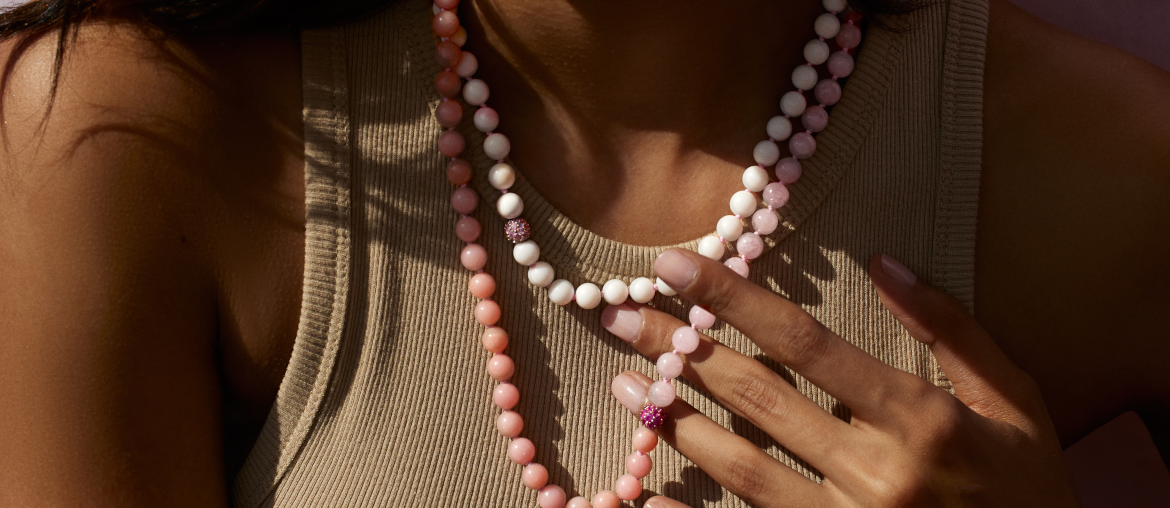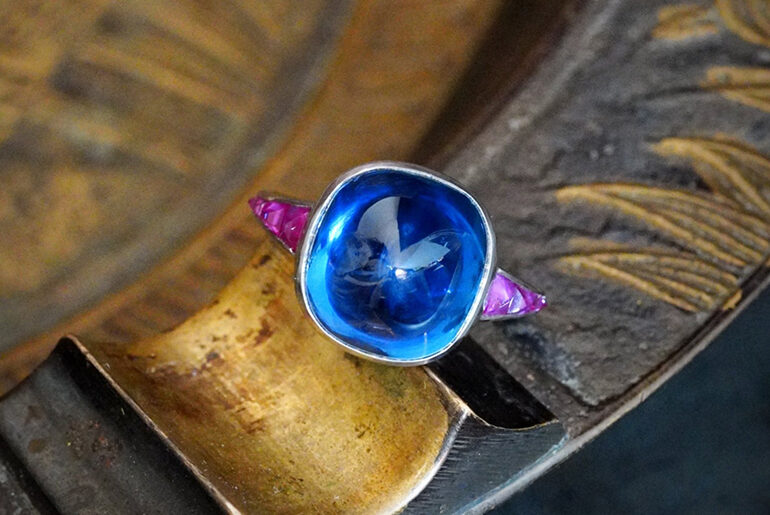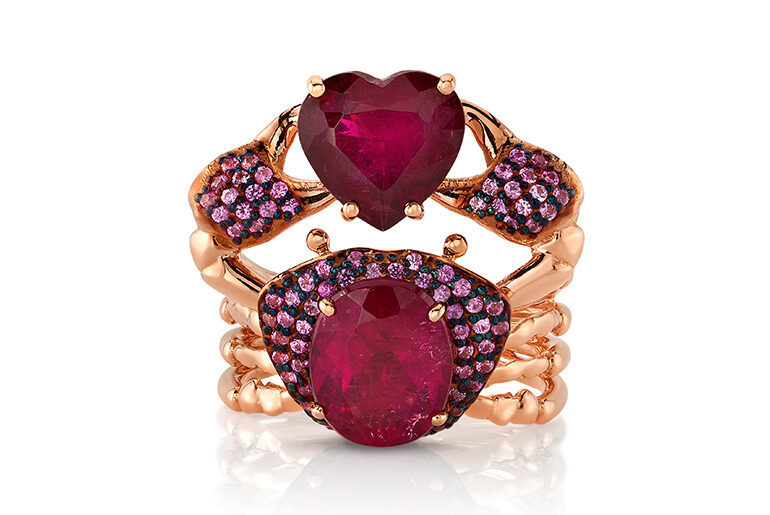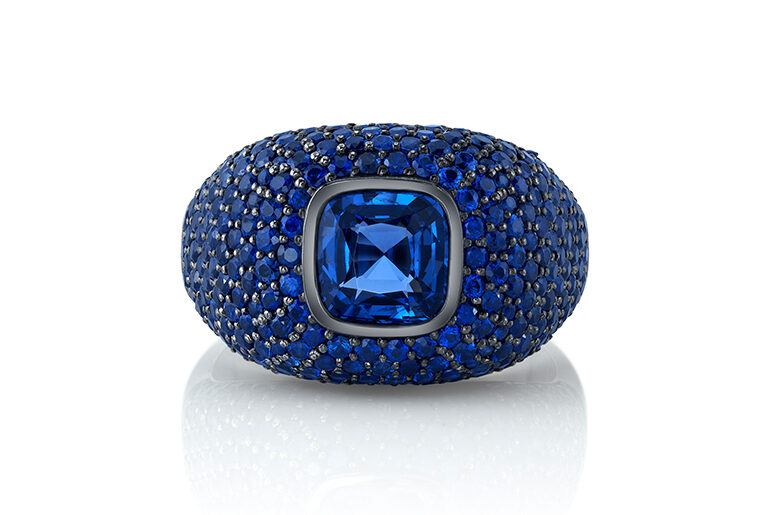Non-precious varieties of opal come in a slew of exotic colors for jewelers to play with.
Opal is a glamorous mainstay in the jewelry trade. Precious opal’s play-of-color happens when white light diffracts through the silica spheres, breaking up into spectral hues. But another variety is gaining momentum: common opal. Unlike its precious counterpart, this variety lacks play-of-color. But contrary to its moniker, it’s anything but common; it comes in an array of tints, sometimes with evocative inclusions — perfect for collectors who crave the unfamiliar.

Beyond Australia
Today, Australia’s precious opal still dominates the market, supplying more than 90% of global opal output. But countries like Guatemala, Zambia, Peru, Canada, Poland, New Zealand, Indonesia, Mexico, the US and Brazil offer an exotic array of non-precious opals for consumers seeking something different.
Over the last three decades, there’s been an explosion of common opal in the market, including pink and blue material from Peru, blue-green from Indonesia, and leopard opal from Mexico, says gemologist Carlos Torres. These varieties are opaque to translucent, and specimens with even coloration and greater translucency command higher prices.

“Fine-grade pink Peruvian material might be sold between $50 and $90 per carat for 5-carat or larger sizes,” Torres reports. “Good grades sell around $20 to $50 per carat. Nearly transparent material might go for as high as $100 per carat, but stones larger than 5 carats are very rare.”
US-based Outlaw Rocks Mining Company offers a rainbow of shades, including “Oregon white, pink, red, blue, caramel, chocolate and fire opal,” according to co-owner Michelle Shepherd.

Fernando Jorge Gravity ring in 18-karat gold with pink opal and diamonds. Photo: Fernando Jorge.
“We are in the Ring of Fire, an area prone to volcanic activity and earthquakes,” she continues, explaining the geology behind opal’s presence in the region. “The fire opal mine is full of volcanic vents from ancient hot springs, which we follow. They eventually lead to pools of opal, vugs [cavities in the rock] and seams.”
Outlaw’s chocolate translucent fire opal sells for $700 per kilogram, while orange and yellow versions are $800 per kilogram. Shepherd’s favorite is “the deep red fire opal. It’s just stunning in jewelry.”

Treating and curing
Opal is amorphous rather than crystalline, with a high water content — up to 21% in some cases. As such, it requires expert care both before and during the cutting process. Gem-cutter Mike Soebbing, owner of The Gemstone Man, learned the hard way when he began faceting Juniper Ridge opal from Idaho in 2013.
“I discovered that it must cure [dry out slowly] for at least six months prior to faceting,” he recounts. “If not cured properly, it can crack at any time during or after the cutting process. Additionally, the pieces I worked [with] slowly clouded.”
Curing methods vary, but some lapidarists place the rough in ziplock bags without drying it first, then store it away from heat for six months to a year before cutting it.

Greenwich St. Jewelers Chroma necklace in 14-karat gold with multicolored opals. Photo: Greenwich St. Jewelers.
Because precious opal’s play-of-color is a highly desirable trait, treatments have been developed to bring out the stone’s best look.
Matrix opal often undergoes a simple process of cooking in a sugar solution and then immersion in sulfuric acid, which gives it a black-opal appearance. An ancient method of wrapping the stone in newspaper or bark and then cooking or smoking it is popular with Ethiopian hydrophane material — a porous precious variety that absorbs water easily — to produce that coveted black-opal façade and accentuate the play-of-color. However, common opals like Peruvian blues or pinks are not routinely treated, according to dealer Oke Millett of Discovery Gems & Jewellery.

Akaila Reid mini hoops in 18-karat gold with pink opal drops. Photo: Akaila Reid.
Moving on up
With the rise of common material in the market, we can expect to see more high-end goods featuring opal. “Over the years, we have seen brands like Boucheron, Irene Neuwirth, and Lorraine Schwartz use all opal varieties, from Australian black opal to Mexican fire opal to Ethiopian Welo [smoked] opal,” states Torres.
Designer Yehouda Saketkhou affirms the appeal of the lesser-known types: “Peruvian pink opal has incredible beauty. It looks like conch pearls.”

Common opal “is so underrated,” agrees dealer Frank Schaffer, owner of FGS Gems. “I carry several grades, all the way up to the super-hot translucent material.”
And while high-quality common goods have been around for years, they’re now getting the attention they deserve. “Plenty of my top-grade opal was mined in 1999,” says Schaffer, and lately, “it’s been selling fast.”

Four millennia of shimmer
Arguably one of antiquity’s most kaleidoscopic gems, opal dates back some 4,000 years, according to 20th-century anthropologist Louis Leakey. Early humans began hoarding these hypnotic rocks, and they never looked back. In a remote Kenyan cave, Leakey — who died in 1972 — uncovered the world’s oldest known opal artifacts. Scholars believe they were originally from Ethiopia and served as tools, not adornment.
In 75 CE, Roman naturalist Pliny the Elder established the concept of play-of-color by pointing out opal’s dancing “play of rainbow colors.” Comparing opals to volcanoes and vibrant paintings, he maintained that this stone could mimic the colors of any gem.
Medieval Hungary mined opal for European and Middle Eastern collectors. But in the Americas, it was Mexico, Peru and Honduras that supplied indigenous empires with opal. Spanish explorers sent this New World stone back to Spain in the 16th century.
During the Middle Ages, superstitious folk believed opal brought luck to the wearer, but later generations considered it a bad omen. French Belle Époque actress Sarah Bernhardt helped revive demand for opal in the late 19th century; for her role as Cleopatra, she commissioned a ruby-eyed cobra bracelet and ring with opal inlay.
The discovery of deposits in Australia in 1850 increased the appetite for this colorful stone. After Britain’s Prince Albert gifted Queen Victoria opal jewelry, the queen made it a tradition to give her daughters opal jewelry at their weddings. This sealed the gem’s popularity in high society.
By the 1970s, simulated and lab-created opals were showing up in the market. While early iterations were easy to distinguish from their natural counterparts, later versions looked surprisingly realistic.
Today, opals have remained popular thanks to recent discoveries in Ethiopia, as well as the mining of common specimens that lack play-of-color.
Left image: Boucheron opalescence necklace, on model. Photo: Boucheron.
Main image: Emily P. Wheeler necklace in 18-karat gold with pink opals, sapphires, morganites, white agate, conch shell, and pink enamel. Photo: Emily P. Wheeler.





Comments are closed.